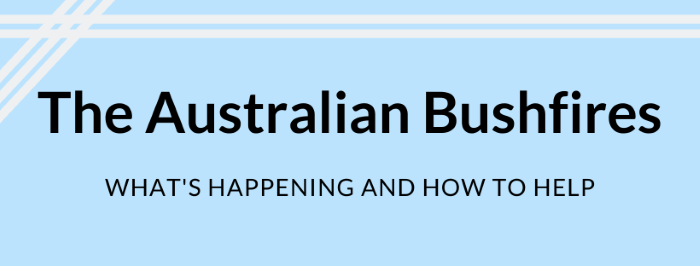Over the past few days, the Australian bushfires have been at the top of the international news. World leaders are speaking out about the fires and how they represent the threat of climate change. I wanted to share some more in-depth information about the severity of the fires, and how best to help those affected now and in the coming months.
The problem
Wildfires are common in Australia, especially during the hotter summer months, but the intensity and longevity of the current fires are unprecedented. While the bushfires just recently came to the attention of the US, they’ve actually been burning for several months. After two years of drought, the bushfires are particularly severe now that it is summer in the southern hemisphere.
The bushfires are concentrated in the states of Queensland and New South Wales. Over 20 people have died as a result of the fires, which are expected to continue burning for several months.
Every year, the Australian government undertakes hazard reduction efforts to prevent and contain the fires. This includes prescribed burning and removing vegetation that could act as fuel for fires. However, hotter and drier conditions have made it difficult to carry out these hazard reduction strategies, contributing to the severity of the fires.
The Guardian has the most current coverage of the rapidly-changing situation in Australia. You can view a current map of the fires here.
The Australian bushfires represent the threat of drought caused by climate change around the world. California has suffered from intense wildfires in the past year, and migration from Guatemala is driven in part by drought affecting subsistence farmers.
How you can help
If you want to help those affected by the bushfires, the Center for Disaster Philanthropy recommends cash donations to local organizations that are already working in the area as the most effective way to help. Cash donations are particularly helpful in disaster relief because they can be used by local organizations as they need. Funding to rebuild communities and infrastructure will be especially important in the coming months. Read more of the CDP’s assessment of the bushfires and their recommendations here.
Donating directly to local organizations with a prior relationship to the area, rather than outside groups or intermediary organizations, is the most effective way to support those affected by the bushfires. For example, local fire brigades are trained to support their communities in emergency and non-emergency capacities.
- College Football, Ariana Grande, and Water - September 3, 2023
- Livestock and Land Use: How Are We Feeding The Planet? Impactfull April 2022 - April 19, 2022
- What Does Voluntourism Look Like? A Case Study in a Cambodian Orphanage - March 28, 2022
